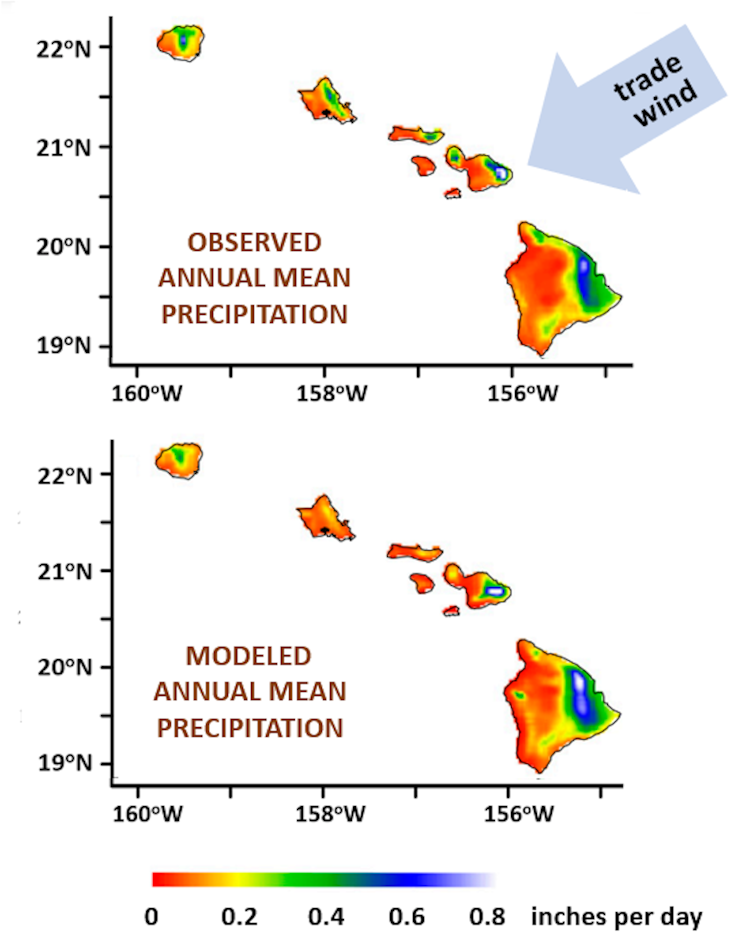The islands of Hawaii are world renowned for their generally pleasant and tranquil weather. However, the Aug. 8, 2023, wildfire tragedy on Maui was a stark reminder that Hawaii also can experience drought and hot, dry, windy weather, providing the conditions for destructive fires.
Hawaii has seen a generally rising trend in the amount of land that burns each year as the local climate warms. Climate change was one of several contributors to Maui’s wildfire catastrophe, and rising temperatures and associated rainfall changes are expected to increase the islands’ fire risk. These changing weather patterns will also affect Hawaii’s ecosystems and freshwater resources.
I am a meteorologist at the University of Hawaii, and I have worked with colleagues to develop sophisticated computer climate simulations that project local rainfall changes over the 21st century.
Our results suggest that as the planet warms, Hawaii’s dry regions will get drier, heightening the fire risk. At the same time, its wet areas will become wetter.


The drier parts of the state in particular have reason to be concerned about the future of fresh water available for residential, commercial and agricultural uses. In addition, changes in rainfall are expected to affect the distribution of plants in Hawaii, harming some unique native species such as silversword and increasing some invasive grass species that enhance fire danger.
Average rainfall drops sharply in the rain shadow
While Hawaii is home to some of the wettest spots on earth, it also has regions that receive little rain.
The very steep mountains on each of the main Hawaiian islands block the prevailing northeast trade winds. This results in abundant rain on the slopes facing the windward direction and dry “rain shadows” in the leeward areas. Maui’s west coast tourist communities, including Lahaina, are in one of those rain shadows.

Hawaii is remarkable for its exceptionally strong gradations in the average rainfall rates over very short distances. The summit of Mt. Waialeale in central Kauai, known as one of the rainiest places on Earth, receives an average of about 450 inches of rain per year. The town of Kehaka, 15 miles to the southwest and in the rain shadow, receives less than 20 inches per year on average.
These sharp differences over short distances have made projecting future climate change in Hawaii a particularly daunting challenge.
Computer models used to project the future climate approximate the atmospheric wind, temperature and humidity at discrete points on a regular grid. The horizontal spacing between grid points in global climate models is typically 20 miles or larger. To put that in perspective, Maui is only 26 miles by 48 miles at its widest.
Predicting Hawaii’s changing climate
We created a model that zooms in on Hawaii and is able to capture those variations, including the rain shadow effect.
Using that model, we simulated the Hawaiian climate at the end of the 21st century under a scenario in which global greenhouse gas emissions from human activities continue at a rate that drives a global increase of temperature of about 4 degrees Fahrenheit (2.2 C). Such a scenario is quite plausible and even demands some significant reduction in current emission rates, but still pushes well beyond the internationally agreed goal of keeping global warming under 3.6 F (2 C) compared with preindustrial levels.
We found that in the wet windward areas of Hawaii, rainfall is projected to increase substantially. That includes increasingly frequent extreme downpours. On the other hand, rainfall is predicted to decrease substantially over much of the rain shadow regions.
This overall “wet gets wetter and dry gets drier” trend is generally found in global model projections of climate warming. Our computer model shows that it also applies to the rainfall gradations over the very short distances relevant for Hawaii.
The “dry gets drier” aspect is particularly important for formulating Hawaii’s plans to adapt to climate change. The soil in already dry regions may become even drier as rainfall decreases and warmer air promotes more evaporation from the surface. That includes Maui’s highly developed west coast and agricultural areas that until recently were home to large sugar cane farms.
Developing better projections to help prepare
Rainfall rates will still vary year to year. Indeed, Hawaii rainfall is known to display quite strong year-to-year and even decade-to-decade variations, due in large part to the influences of El Niño and the Pacific decadal oscillation, both natural climate patterns. Such natural variations are expected to coexist with the overall centurylong trend toward drier or wetter conditions.
Simulating rainfall in climate models still has many uncertainties, and there are particular challenges in representing the fine geographical details of the rain in Hawaii. Another study using a different approach produced results broadly consistent with ours but projects an overall stronger drying trend in the islands.
While further research should help reduce the uncertainties in climate projections, our results suggest that, in the long term, Hawaii needs to prepare for more extreme conditions, including a heightened risk of wildfires.
![]()
Kevin Hamilton, Emeritus Professor of Atmospheric Sciences, University of Hawaii
This article is republished from The Conversation under a Creative Commons license. Read the original article.





